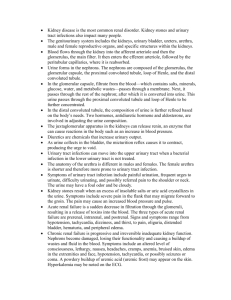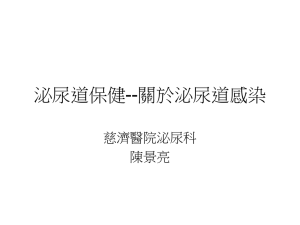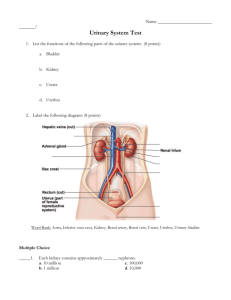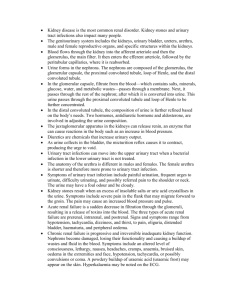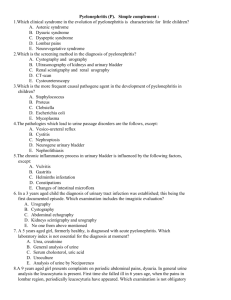Mel`s Renal Outline
advertisement
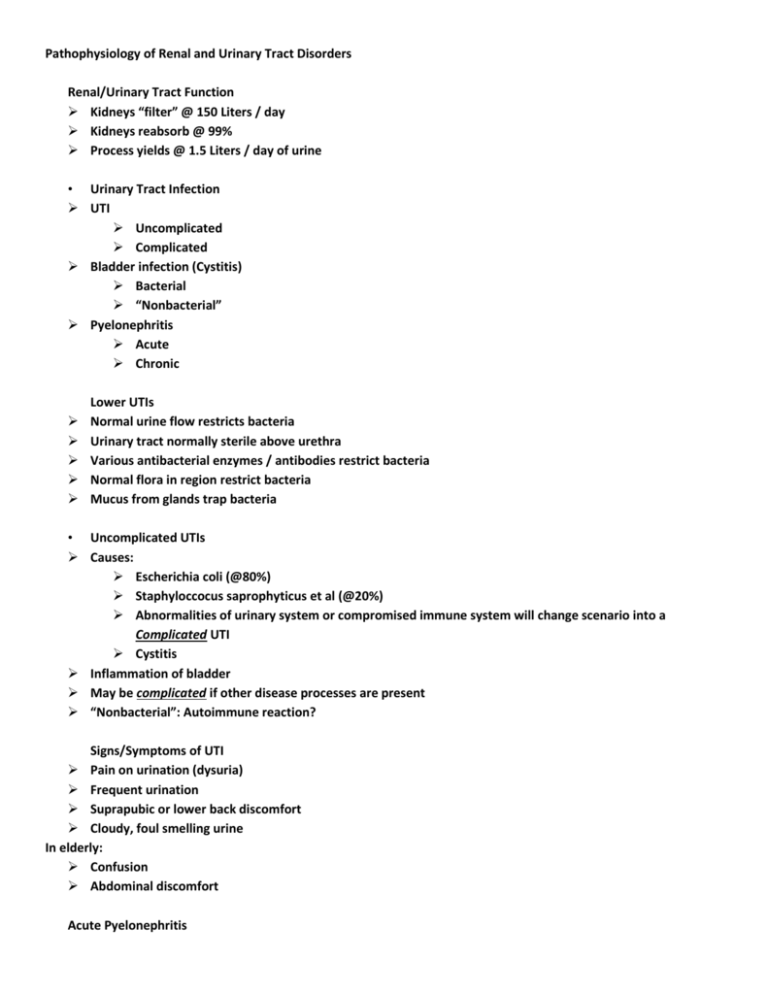
Pathophysiology of Renal and Urinary Tract Disorders Renal/Urinary Tract Function Kidneys “filter” @ 150 Liters / day Kidneys reabsorb @ 99% Process yields @ 1.5 Liters / day of urine • Urinary Tract Infection UTI Uncomplicated Complicated Bladder infection (Cystitis) Bacterial “Nonbacterial” Pyelonephritis Acute Chronic Lower UTIs Normal urine flow restricts bacteria Urinary tract normally sterile above urethra Various antibacterial enzymes / antibodies restrict bacteria Normal flora in region restrict bacteria Mucus from glands trap bacteria • Uncomplicated UTIs Causes: Escherichia coli (@80%) Staphyloccocus saprophyticus et al (@20%) Abnormalities of urinary system or compromised immune system will change scenario into a Complicated UTI Cystitis Inflammation of bladder May be complicated if other disease processes are present “Nonbacterial”: Autoimmune reaction? Signs/Symptoms of UTI Pain on urination (dysuria) Frequent urination Suprapubic or lower back discomfort Cloudy, foul smelling urine In elderly: Confusion Abdominal discomfort Acute Pyelonephritis Infection of renal pelvis, tubules, & interstitial tissue of one or both kidneys Causes: Upward spread of bacteria from bladder Spread of bacteria via bloodstream • S/S of Acute Pyelonephritis Enlarged kidneys w/ abscesses Fever / chills Leukocytosis, bacteriuria, pyuria Low back pain N/V, headache, malaise Painful urination Chronic Pyelonephritis Persistent, recurring infection Leads to scarring of kidney(s) Difficult to determine specific cause Kidney stones increase risk Vesicoureteral reflux increases risk Urinary Tract Obstruction Lower urinary tract disorders Enlarged prostate (men) Urethral stricture Pelvic organ prolapse (women) Kidney stones Renal tumors Bladder tumors Enlarged Prostate (Male) Often is benign = called Benign Prostate Hypertrophy (BPH) Prostate CA Either lead to obstruction of urethra Urethral Stricture (Male or Female) Causes: Congenital Infection Injury Surgical manipulation Any of these may cause scarring & narrowing of lumen Pelvic Organ Prolapse (Female) Downward protrusion of bladder into vagina Causes bladder outlet obstruction Renal Calculi (Kidney Stones) May form anywhere in urinary tract Usually form in renal pelvis or calices Vary in size, shape, & number 70-80% made of calcium oxalate or calcium phosphate Patho of Kidney Stones Urine becomes concentrated w/ insoluble materials→Crystals form, then consolidate→ calculi form→Calculi remain in renal pelvis (damage/destroy kidney tissue), or enter the ureter→Large caluli may cause pressure necrosis Causes / Predisposing factors: Dehydration Infection Obstruction Changes in urine pH Immobilization Diet Metabolic factors (Ex: gout, hyperparathyroidism) Calculi—Signs/Symptoms Severe pain—may move from lower back to sides to pubic region N/V Often fever / chills May have hematuria May have abdominal distention May have oliguria Renal Tumors Renal cell carcinoma (RCC) most common Tobacco use, obesity, HTN appear to be associated w/ RCC Usually occur in one kidney & metastasize to lungs, liver, lymph, & bone Renal cell adenoma (benign tumor) Encapsulated & located near renal cortex Signs/Symptoms of Renal Tumors Early stages are often silent Late signs include Hematuria Flank pain Palpable flank mass Weight loss Tobacco use appears to be leading risk factor Arise from alteration of epithelial tissue at base of bladder Often involve ureter orifices and bladder neck Usually metastasize to lymph, liver, bones, & lungs Signs/Symptoms of Bladder Tumors Visible, painless hematuria Pelvic or back pain may occur with metastasis UTIs are common complications→ frequency, urgency, dysuria Glomerular Disorders Glomerulonephritis Acute Chronic Nephrotic Syndrome Nephrosclerosis Glomerulonephritis Inflammation of the glomerulus Acute glomerulonephritis is often associated w/ strep throat, or impetigo→develops 2-3 weeks post infection Chronic glomerulonephritis is often caused by IDDM or Lupus erythematosus→leads to chronic renal failure Patho of Glomerulonephritis Infection initiates inflammatory process→Antigen-antibody processes deposited in glomeruli→Nephrosclerosis develops→(In chronic) Cortex layer shrinks→Bands of scar tissue distort remaining cortex→Branches of renal artery thicken→End-stage renal disease • Nephrotic Syndrome Can occur with any renal or systemic disease process that damages the glomerular capillary membrane → Large amounts of protein excreted in urine (proteinuria) Decrease of albumin in blood (hypoalbuminemia) High serum cholesterol and low – density lipoproteins (hyperlipidemia) Major S/S: Edema (pitting & ascites) • Nephrosclerosis Hypertension & Diabetes main causes→Decreased blood flow to kidneys→Patchy necrosis develops→Fibrosis develops; glomeruli destroyed→Leads to End-stage renal disease • Acute Renal Failure Abrupt reduction in renal function w/elevation of BUN & creatinine levels Usually associated w/ urine output of <30 ml/hr or <400 ml/day Most of the time condition is reversible • Signs/Symptoms of ARF Oliguria begins within 1 day post hypotensive event & lasts 1 - 3 weeks Lethargic Skin / mucus membranes dry CNS→headache, muscle twitching, seizures Many body systems affected Recovery depends on how long the cause lasted • • Chronic Renal Failure ESRD is progressive, irreversible deterioration in renal function End products of protein metabolism (normally excreted in urine) accumulate in the blood Causes: Diabetes mellitus HTN Chronic glomerulonephritis Pyelonephritis Obstruction of urinary tract Signs/Symptoms of ESRD UREMIA (result of accumulation of toxins in plasma): HTN Anorexia Nausea / vomiting Diarrhea Weight loss Pruritis Edema Anemia Neurological changes


